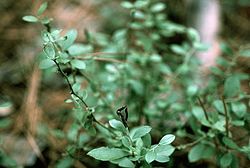| Small black blueberry | |
|---|---|
 | |
| Scientific classification | |
| Kingdom: | Plantae |
| Clade: | Tracheophytes |
| Clade: | Angiosperms |
| Clade: | Eudicots |
| Clade: | Asterids |
| Order: | Ericales |
| Family: | Ericaceae |
| Genus: | Vaccinium |
| Section: | Vaccinium sect. Cyanococcus |
| Species: | V. tenellum |
| Binomial name | |
| Vaccinium tenellum Aiton | |
| Synonyms [1] | |
Cyanococcus tenellus(Aiton) Small | |
Vaccinium tenellum, also known as the small black blueberry or southern blueberry, is a plant species native to the southeastern United States from southeastern Mississippi to northern Florida to southern Virginia. It grows in forests and in shrubby areas at elevations up to 656 ft (200 m). [2]
Vaccinium tenellum is a deciduous shrub up to 31 in (80 cm) tall, often forming large colonies. Leaves are elliptic, up to 1.5 in (4 cm) long. Flowers are white or pale pink, cylindrical, up to 3/8 in (10 mm) long. Fruits are very dark blue, almost black, about 1/4 in (7 mm) across. [2] [3] [4] [5] [6] [7] Cytology is 2n = 24. [8]

